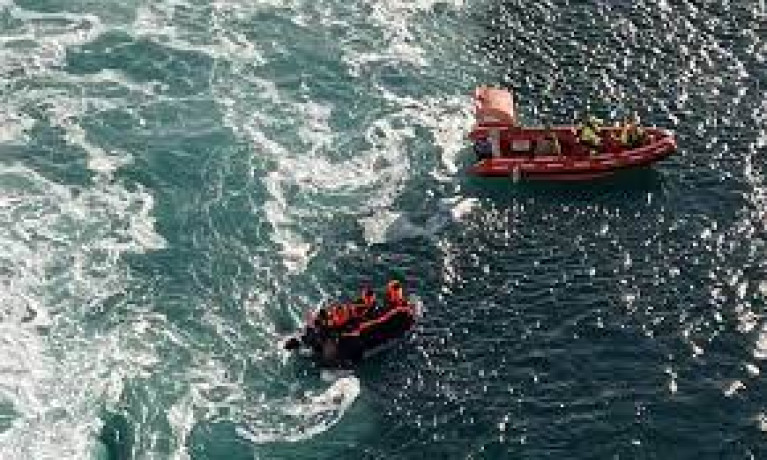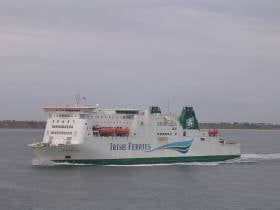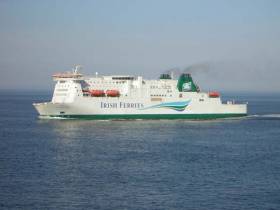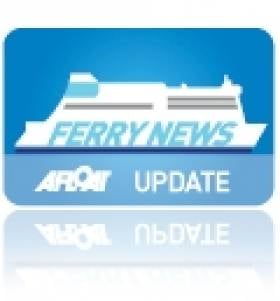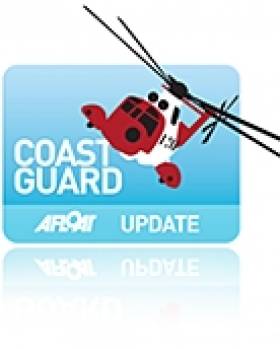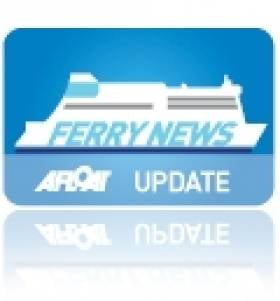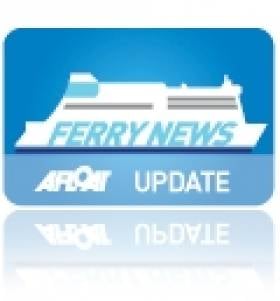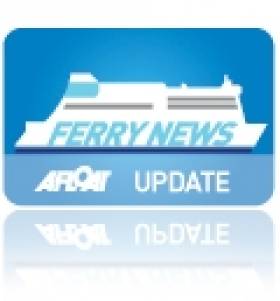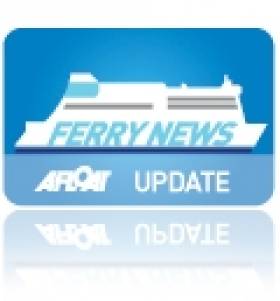Displaying items by tag: Isle of Inishmore
Irish Ferries Dover-Calais Ferry Stops to Rescue Migrants on Sinking Boat and Returns to France
An Irish Ferries ship operating on the Strait of Dover was forced to stop to rescue more than a dozen migrants in a sinking dinghy and return them to France, reports The Telegraph.
Crew on the Isle of Inishmore threw a rope to the 13 migrants to help pull their craft to the side of the ship, before rescuing them and returning them to Calais.
The ferry captain announced to the passengers: “Apologies for the delay, but we had to stop and rescue 13 migrants in distress, whose boat had run out of fuel and was sinking.”
It is thought to be the first time there has been such a rescue and came as a migrant in his 30s died when a boat packed with 40 people sank off the French coast near Dunkirk. A second migrant was reported missing.
Sebastien Pive, Dunkirk’s public prosecutor, announced a manslaughter inquiry, saying the boat had been so overloaded it broke down and sank.
It is the second channel tragedy in just over a week, after three Somali migrants were lost at sea from a dinghy that was finally picked up 30 miles off Harwich, in Essex. Two other Somalis were rescued from the boat.
For more on the record number of migrants reaching the UK, click here.
Cruiseferry Isle of Inishmore Enters 21st Year of Service
#FerryNews - Following last week's hull launch of ICG's biggest cruiseferry W.B. Yeats in Germany, Isle of Inishmore completed a routine annual overhaul and departed a drydock in the UK on Monday, writes Jehan Ashmore.
Afloat adds the Isle of Inishmore today made a first sailing in 2018, a year that will mark 21 years of service for Irish Continental Group (ICG) the parent company of operator Irish Ferries.
ICG placed the order for Isle of Inishmore with Van der Giessen-de Noord shipyard in The Netherlands and entered service on the Dublin-Holyhead route in 1997. Then easily the largest ever ferry to operate the Ireland-Wales route having replaced a smaller cruiseferry, Isle of Innisfree. That was ICG's first custom-built ferry when launched into service only two years previously.
Demand for more freight capacity during the run up to the Celtic Tiger era led to this second much larger cruiseferry from the same Dutch shipbuilders. The yard located in Krimpen aan de Ijssel, Rotterdam, however has since closed.
At 34,031 gross tonnage, Isle of Inishmore with a capacity for 2,200 passengers/ 800 cars and 150 trucks, remains after two decades, the second largest ferry (after Ulysses), currently serving between Ireland and the UK.
The 1,875 passenger flagship Ulysses with vehicle space for 1,342 cars and 330 trucks was introduced in 2001 and replaced Isle of Inishmore from the Dublin service. This morning, the cruiseferry resumed sailings for the first time this year on the Rosslare-Pembroke route.
The Dutch built Isle of Inishmore which has an extensive range of passenger facilities, continues to be the largest cruiseferry in terms of passenger capacity operating in north-western Europe.
Afloat had previously tracked Isle of Inishmore from the drydock facility of Cammell Laird in Birkenhead on Merseyside and which led to an arrival to Dublin Port on Monday. The call to the capital was brief as the cruiseferry completed the repositioning voyage to Rosslare Harbour yesterday.
While Isle of Inishmore was off-service on the south Wales route, sailings were covered by Oscar Wilde. Previously, the cruiseferry provided additional capacity over the festive /new year season on the Dublin route. In recent days, however sailings on the Rosslare route were cancelled due to adverse weather conditions.
Also this morning, Afloat tracked Oscar Wilde having rounded Anglesey, north Wales and is bound for Birkenhead to also undergo routine drydocking. At this quite time of year, Irish Ferries Jonathan Swift is already at the drydock facility having completed fastferry crossings on the Dublin-Holyhead route.
Body Recovered In Search For Woman Missing From Irish Sea Ferry
#Ferry - The body of a woman was recovered from the water in South Wales yesterday (Friday 2 December) after a major search operation for a person missing from a Pembroke-to-Rosslare ferry, as the Western Telegraph reports.
Irish Ferries’ Isle of Inishmore contacted the UK Coastguard from Rosslare shortly after 8am when the passenger was noted as missing and feared to have gone overboard, according to Sky News, prompting a major air and sea search of the Irish Sea and the Pembroke Channel at Milford Haven.
Dyfed Powys Police later confirmed the discovery of a body in the Lawrenny area east of Pembroke Dock in the upper reaches of the Western Cleddau, though it has not formally been identified.
Irish Ferries Fleet Start Dry-Docking Schedule
#FERRY NEWS- This morning Irish Ferries Dublin-Holyhead route cruiseferry Ulysses departed for Birkenhead, on the Mersey, for annual maintenance at the Cammell Laird dry-docks facility, writes Jehan Ashmore.
In place of Ulysses, the Isle of Inishmore has taken up her sailing roster, as previously reported on Afloat.ie, the ro-pax ferry had last night completed her own additional sailings to cope with increased demand over the festive season.
Isle of Inishmore which normally operates the Rosslare-Pembroke Dock route, will too be dry-docked for 15 days at the same facility, releasing Ulysses which is expected to return to service on 14 January, with the 08.50hrs sailing to Holyhead.
When the 'Inishmore' is off service, she will be joined by the central-corridor route's fast-craft Jonathan Swift, albeit in a separate dock, remaining there until 2 February.
Once work on Isle of Inishmore is completed, she is planned to vacate the dock on 30 January, which in turn will allow cruiseferry Oscar-Wilde to enter the next day, for her period of routine maintenance.
This will allow Isle of Inishmore to return to the Rosslare-Pembroke Dock route, where the Oscar Wilde is currently operating. The French routes ferry Oscar Wilde will finally return to launch the Cherbourg route on 27 February, followed by high-season sailings to Roscoff beginning in May.
#COASTGUARD - The Irish Coast Guard has ended its search for a ferry passenger believed to be missing off the coast of Wexford, as the Irish Examiner reports.
The alarm was raised early yesterday morning when the passenger, who had been travelling by coach on the Irish Ferries vessel Isle of Inishmore from Pembroke to Rosslare, was not on board the ferry on arrival in Wexford.
Though the coastguard has stood down its search, Gardaí at Rosslare were as of yesterday continuing to search the shoreline.
Irish Ferries 'Flagship' Returns to Dublin Route
#FERRIES - Ulysses arrived fresh from refit on the Dublin-Holyhead route yesterday after annual dry-docking at Cammell Laird, Birkenhead, writes Jehan Ashmore.
As previously reported on Alfoat.ie the Irish Ferries 'flagship' sailings on the central corridor route (also served by Jonathan Swift) where relieved by Isle of Inishmore earlier this month.
Isle of Inishmore departed Dublin Port last evening and headed to Liverpool Bay, where she anchored overnight. She docked at Cammell Laird this afternoon, where she too is to undergo annual overhaul.
With Isle of Inishmore off service on her usual Rosslare-Pembroke Dock route, the company's French routes vessel, Oscar Wilde is maintaining sailings.
On 19th February, the Oscar Wilde resumes service on Rosslare-Cherbourg route and she will also re-open the seasonal-only operated route to Roscoff which starts in May.
Bad Weather Continues to Disrupt Ferry Sailings
#FERRIES - As the adverse weather continues, ferry services across the Irish Sea remain affected, with several crossings cancelled, writes Jehan Ashmore.
Irish Ferries 08.05hrs sailing this morning from Dublin to Holyhead operated by Isle of Inishmore, departed over three hours later than her scheduled time.
Last night she had just been deployed on the route so to cover sailings usually operated by Ulysses, which went off-service for annual dry-docking at Cammell Laird, Birkenhead, as previously reported on Afloat.ie
In addition the fast-ferry craft sailing at 08.45hrs from Dublin Port served by the Jonathan Swift were cancelled and the following sailings are also cancelled:
Dublin -Holyhead 14.30hrs
Holyhead-Dublin 12.00hrs AND 17.15hrs
Passengers booked on the Jonathan Swift instead will be accommodated on the Isle of Inishmore. For further information on Dublin-Holyhead sailing updates click HERE.
On the Rosslare-Pembroke Dock service, sailings were too cancelled with last night's sailing from Wales, which are currently served by Oscar Wilde. She sailed as scheduled with this morning's 08.45hrs sailing to Pembroke Dock.
To keep updated on Rosslare-Pembroke Dock sailings click HERE.
For further information, Irish Ferries Central Reservations contact: 0818 300 400 and for Irish Ferries, Rosslare Harbour contact: 00353 53 9133158
STENA LINE
For information on sailing schedules and updates from the company's Ferrycheck facility click HERE.
To contact Stena Line call: 003531 204 77 99 when travelling to Britain or 0044 (0) 8705 755 755 when travelling to Ireland or Scotland
P&O FERRIES
Dublin to Liverpool sailing at 1500hrs is cancelled and passengers will be accommodated on either 2130hrs tonight or 0900hrs on Friday 6th January.
For other sailings and on the Larne-Cairnryan click HERE and to contact +44 (0) 871 66 44 777 if calling from UK
OR (01) 407 34 34 if calling from ROI. In addition to latest sailing infomation on +44 (0)845 832 8888
FOR OTHER FERRY OPERATORS
Please click this LINK and choose the relevant highlighted ferry route for further information.
Ferry Go-Round
# FERRY NEWS - Irish Ferries French routes cruiseferry Oscar Wilde (1987/31,914grt) took over Rosslare-Pembroke Dock sailings with this morning's sailing, instead of the usual route vessel that operates on the southern corridor route, writes Jehan Ashmore.
Currently there are no services running to Cherbourg until February, though Oscar Wilde is covering in for the Welsh route ferry Isle of Inishmore (1997/31,031grt). She in turn is due to relief Dublin-Holyhead sailings from tonight on the route which is normally served by flagship Ulysses (2001/50,938grt) which heads off for dry-docking.
In the meantime Isle of Inishmore is in Rosslare after completing last night's sailing from the Pembrokeshire port. She is due to make a repositioning voyage with an arrival into Dublin Port this evening and followed by a brief turn-around at the ferryport, she is take over the route's roster with tonight's 20.55 crossing to Holyhead.
Ulysses Celebrates 10 Years of Irish Sea Service
In January 2000 the keel of the worlds largest car ferry was laid at the Aker Finnyards in Rauma, Finland. The following year the €100m cruiseferry giant departed the shipyard on a four-day delivery voyage to Dublin Port. Upon Ulysses's arrival on 4th March she was presented with a traditional welcoming escort of saluting water-firing tugs.
The Ulysses was named at a ceremony in the port on 21st March by the 'golden godmother' Mairead Berry, Ireland's 25-year old Paralympic Games gold medallist. Four days later Ulysses made her commercial maiden voyage to Holyhead on 25th March.
Wih 12 decks the vessel has an extensive range of facilities and they are named with themes derived from James Joyce's famous novel 'Ulysses'. There is seating available for up to 1,938 passengers and there are 117 twin or single-cabins, accommodating up to 228 passengers.
Only two months into service the Ulysses won the prestigious 'Most Significant New Build - Ferry' category award in the Cruise & Ferry magazine 2001 Awards competition. Her Finnish builders are not only builders of large cruise-ferries for Baltic Sea operators and beyond but also are also renowned for the construction of very large cruiseships for international clients.
Ulysses was designed specifically to serve the central corridor route with a schedule of two round trips daily. She directly replaced the 1997 Dutch built 34,031 grt ro-pax Isle of Inishmore, which transferred to Rosslare-Pembroke Dock service.
In 2006 the Ulysses alongside her fleetmates were transferred from the Irish flag to the Cypriot flag in addition to a change of Irish crew with those outsourced from citizens mostly from the Baltic and Eastern European countries.
Due to the sheer size of the Ulysses, which has a length of 209m, a beam of nearly 32m and a 6.4m draught, she has not missed a single crossing due to bad weather conditions. The vessel has a 22 knot / 41kph service -speed on the 60-mile route which translates to a distance of over 182,000 kms a year.
To celebrate Ulysses 10th year in service, Irish Ferries has enhanced the Club Class option to passengers which includes free-Wifi, which enables a constant connection and an array of other benefits during the 3-hour 15 minute crossing.
For a virtual tour of the Ulysses with views taken from the top deck as the cruiseferry departs Holyhead and the mountains of Snowdonia setting as a backdrop plus interior tours of the vessel click here.
Irish Ferries Signs 10-Year Contract On Welsh Route
The St. Georges channel crossing carries over 300,000 passengers and 80,000 freight annually and is served by the 34,031grt Isle of Inishmore. The ro-pax can handle 2,200 passengers, 802 cars / 152 freight trailers and is scheduled to two daily round trips, on a route that take nearly five hours.
The 1997 Dutch built vessel was first launched onto the central corridor route between Dublin-Holyhead but was transferred to the southern service after the introduction of Ulysses in 2001.
Rosslare-Pembroke Dock sailings only began in 1980, firstly operated by the B+I Line which competed with rival operators Sealink / British Rail (now Stena Line) on services running out of Fishguard.
This route was well established having started operations in 1906 and in an era when the railway companies (in this case the Great Western Railway) developed and owned the ports plus the operation of shipping services on the Irish Sea.


























